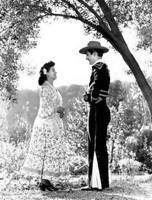
|
The Society of Folk Dance Historians (SFDH)
The Contradanza
[
Home |
About |
Encyclopedia | CLICK AN IMAGE TO ENLARGE |

|
 The way people dance tells much about their personalities and character. Closer examination reveals much more, including their history, values, relationships – even their livelihoods, all revealed in the dance long after they have passed into history and been forgotten.
The way people dance tells much about their personalities and character. Closer examination reveals much more, including their history, values, relationships – even their livelihoods, all revealed in the dance long after they have passed into history and been forgotten.
The ranchos of Early California are a storied time in California's history, yet those who knew of it can no longer describe its charms and values and lifestyle. Who were those Californios who left a legacy now cast in the myths of romantic imagination?
We're told that it was an indolent life, much like that of Old South plantations that existed at the same time, with household servants and field hands providing labor for aristocratic land owners. And perhaps it was, with clearly defined social classes and the economy controlled by a privileged few. Using the Old South as a model, perhaps a little more of the Californios can be revealed through their dance.
We are only able to do this through the fortunate work of Lucile Czarnowski, who, as a young woman in the early 1900s, was able to identify and interview several aged survivors of the California ranchos all the way from San Diego to Sonoma. She recorded their dances and music in her wonderful book, "Dances of Early California."
Of all the dances recorded by Czarnowski, the most important appears to have been the Contradanza, perhaps one of the longest surviving dances in Western history and danced even today by dedicated contra dancers. Tracing its origins back to the minuet of the Western European courts of the Renaissance, the contra dance appears in the ballrooms of Paris, the country villages of 19th Century England, the town halls of America's New England, the haciendas of Mexican California, and the dance halls of modern day America – a span of some 400 years!
The Renaissance introduced new standards of conduct and relationships to Western thought, including the first instance of dancing in a couple relationship with a member of the opposite sex – a truly revolutionary idea. To be sure, couples were required to dance at arm's length and maintain strict standards of posture and bearing while moving and posing through prescribed figures, but they now danced as a couple. We know the dance now as the Minuet.
Dance masters were the driving force that evolved the Minuet into the Contra dance as it now exists, with couples in sets, moving up and down the column of dancers. The dance spread to England and Paris, where it was the height of fashion for generations, gradually losing its stiff formal character. In New England, the frontier lifestyle changed it further into a sometimes rough and casual facsimile of its English parent. The New England contra was a major element in the creation of the American Square Dance in the American settlement of the West.
But to California: The Rancho Period lasted from about 1825 to 1855 – barely 30 years before it succumbed to the American annexation. The land owners ran their ranchos like little kingdoms, indulging in their wealth and importance and creating a lifestyle in which they could relish the Spanish love of music and dance and colorful dress. The fandango became the major social event, complete with dance, music, courtship, extreme hospitality, political and family alliances, intrigue – and a reaffirmation of the very conservative social order.
The Contradanza was a perfect opportunity for that reaffirmation. The "tecolero" (dance caller) placed each couple in the dance in the order of their social position: elders and honored guests at the head, younger senoritas and caballeros next, with vaqueros and their families toward the bottom of the column. In true Contra dance character, the dancers were quickly mixed as couple progressed up and down the set, but in the beginning, there they are in their proper place. Not surprisingly, the Contradanza was the first dance of the fandango, just to be sure that everyone understood the social order from the beginning.
The dance was performed in a style more like the late 1700s in Paris than the casual New England "contra" of the same time. Due to California's remoteness from the rest of the world, they were hopelessly fifty years behind the European fashions they hoped to emulate. It is certain that the many New England sailors who visited at the time had some influence on the dance over the years, evolving it yet again into something uniquely Californian.
Though the New England Contra dances repeat figures as couples progress, the California Contradanza did not. Following the couples' progressing, the "tecolero" called a new figure, so that dancers had to listen carefully through the entire dance. 'Mano Derecha' (right hand figures) and 'Mano Esqueda' (left hand figures); 'El Saludo' (the greeting) allowed a flirtatious wink to ones partner; 'El Cristo' (the Christ) provided the mandatory religious observance; 'La Rueda' (the wheel) and 'La Cadena' (the chain) enabled the progression up and down the set; 'El Nudo' (the knot), 'La Sola' (women's solo), 'La Gloria' (men's solo), and 'Vals Español' (Spanish waltz) are just a few of the many figures with which every dancer had to be familiar.
The music tempo was a slow, dignified Waltz time; the dance character remained elegant and unhurried. To be sure, many a furtive and flirtatious glance was exchanged during the course of the dance.
Interestingly, the Waltz was incorporated into the Contradanza, albeit sparingly. The Californios were far behind the rest of Europe in accepting the closed dance position of the Waltz, introduced by no less a person than Don Juan Bandini of San Diego. Bandini was a devout opponent of the power of the church and he no doubt delighted in dancing the Waltz in defiance of church edicts. One could be excommunicated for dancing it in the padres' presence; it has not been recorded what they did with the padre as they waltzed anyway without benefit of clergy.
The dance traditions of the Californios was rich and varied and reflected the many facets of their lives: their Spanish and Mexican heritage, religious devotion, family relationships, foreign influences, standards of behavior, social position, group and individual personalities, and, most importantly, their statement of membership in the community and their individual place within it.
DOCUMENT
- Richard Duree, an article.
Used with permission of the author.
This page © 2018 by Ron Houston.
Please do not copy any part of this page without including this copyright notice.
Please do not copy small portions out of context.
Please do not copy large portions without permission from Ron Houston.